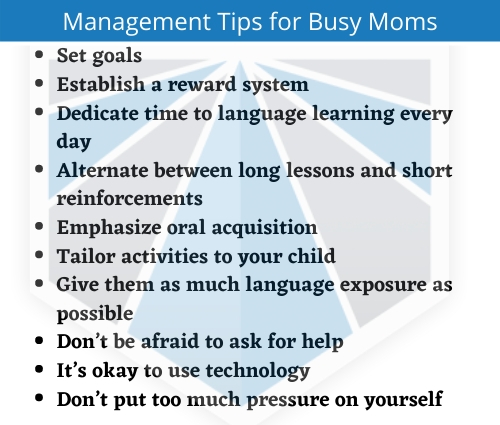
10 Time Management Tips for Busy Moms Whose Kids Learn Spanish
As a parent, you want the world for your kids. You prioritize providing for them and making sure they have plenty of opportunities available to them. Of course, one of the best ways to open doors for your child is through education, specifically language acquisition.
Knowing two (or more!) languages can earn your child higher pay as an adult, offer them innumerable cross-cultural opportunities, and enable them to communicate better in an increasingly connected world.
But, as a busy mom, who has the time and energy to add “language teacher” to their long list of responsibilities? While this may seem like a huge undertaking, it is possible. Trust me!
Language-Learning Management Tips for Busy Moms
When you have made the decision to teach your child a language, organization and intentionality are key. Take a look at the following tips for busy moms who want to teach their kids a new language, and make sure to be intentional about every step.
- Set goals
- Establish a reward system
- Dedicate time to language learning every day
- Alternate between long lessons and short reinforcements
- Emphasize oral acquisition
- Tailor activities to your child
- Give them as much language exposure as possible
- Don’t be afraid to ask for help
- It’s okay to use technology
- Don’t put too much pressure on yourself

Do These Tips Actually Work?
The short answer is yes, absolutely! As a busy mom myself, I have used these tips and tricks to move my son towards fluency in both English and Spanish. As a family, our main language is Spanish. We live in Latin America, so not only do we speak Spanish at home, but it is everywhere we go.
My challenge is teaching him my native language, English. I have had to be very intentional with what language we use for conversation, reading, learning, and watching TV. While it is a daily challenge for me to continue being intentional in teaching him both languages, we have seen huge progress in his language skills, and I can confidently say he is speaking about 50% in English and 50% in Spanish. I have begun to expose him to other languages as well, including Chinese and German.
These time-management tips are things I have learned over time, and they are sure to help you teach your child a new language. As you go through them, keep the following in mind:
- You don’t need to be fluent in a language to teach it to your child. Yes, it helps, but it is not necessary. Many parents embark on the language-learning journey with their child and it becomes a great family learning opportunity.
- You don’t need to break the bank to teach a language. Curriculum, classes, and extra-curricular activities can add up, but there are several quality options at a much lower cost.
- It’s okay to miss a day of language learning or to take a break. Life gets busy, kids get frustrated—it’s understandable! Take your time and adjust these tips to fit your family in the best way.
- Language learning takes time. Don’t put too much pressure on yourself or your kids to start speaking a new language in a week. Look out for progress and reward each improvement!
- Don’t give up! There may be days when it seems like language learning is just another chore and is not making a difference. When those moments come, just remember that all your hard work is definitely paying off. ¡La práctica hace al maestro!

Exploring Time-Management Tips and Tricks in Detail
1. Set Goals
It is incredibly important to set realistic goals. Don’t base them on what other families are doing; take a look at your schedule and have a conversation with your kids to see how much time you can realistically dedicate to language learning. If that’s an hour a day, great! If it’s only 15 minutes most days, fantastic! Any amount of time truly dedicated to language learning is useful. The key is to set a reasonable goal as a family and work towards that together.
If you have a blackboard or learning area in your home, put up your language learning goals. This can be a weekly schedule, a checklist, or just a reminder to study—whatever works best for your little learners. Writing down your goals and hanging them up as a visual for the whole family will help everyone remember and stay on track.
2. Establish a Reward System
Every time you and your kids reach a goal, celebrate it! If you have daily goals, like writing five sentences or performing short monologues in your target language, use a simple daily reward system and work towards a bigger prize. For example, hang up a sticker chart and every day that your child completes their language work, give them a sticker. Once they have 20 (or 50 or 100) stickers, you can give them a bigger reward, like going to the movies or getting to pick out a toy.
This reward system helps everyone stay on track and gives incentives to your little learners. It also helps all you busy moms keep track of your child’s language progress in the midst of everything else going on in your lives. You don’t want your child’s language improvement to get lost in the hustle and bustle of life and then have to repeat old lessons.
3. Dedicate Time to Language Learning Every Day
While taking breaks from studying is one hundred percent okay, consistency is crucial in language learning. Not only does regular studying help commit vocabulary and sentence format to long-term memory, but it also builds confidence and familiarity.
Now, daily language study does not have to look the same every day. Your kids can spend two full hours of language immersion three days a week and only 5 minutes reviewing for the rest of the week. The important thing is to be exposed to the language as many days of the week as possible.
4. Alternate Between Long Lessons and Short Reinforcements
With all your kids’ activities, they can quickly get tired and frustrated. It is imperative to not push them too much and know their limits. One way of avoiding that all together is to alternate language lessons. There are so many different ways to learn a language: online lessons, personal tutors, worksheets, books, television, applications, and full immersion, just to name a few.
Make sure your students have a rotation of these language learning styles throughout the week so your child does not get bored with one specific learning method. Additionally, a combination of long lessons and fun reinforcements engages different language areas: reading, listening, comprehension, speaking, and writing.
5. Emphasize Oral Acquisition
Most generic classes focus on book work, with an emphasis on reading and writing in a foreign language. While those are essential aspects of any language, they do not create oral fluency, which is necessary for travel and bilingual jobs. Additionally, younger students may feel frustrated with the vast amount of reading and writing activities.
Since we naturally learn language verbally and then apply it to reading and writing, it’s more engaging and natural to focus on oral acquisition. You can do this through immersion, tutors, interactive applications, and television.
One of the easiest ways to encourage oral fluency and get in your language study, is to engage your child in conversation in the target language. Ask them what they learned in class, how to say certain vocabulary, and to identify certain objects in their second language. You can do this anywhere (in the car, during a meal, or before bed), which makes it a great timesaver as well as an excellent way to help your child learn a new language.
6. Tailor Activities to Your Child
To avoid long arguments about studying and keeping up with your language learning goals, make sure to grab their attention with engaging activities. Language isn’t all about grammar rules and memorizing vocabulary lists; it can actually be a lot of fun for the whole family.
Look for activities, worksheets, videos, and vocabulary lists for subjects that pique your child’s interest. Whether your kid is into Karate or Paw Patrol, there is a way to integrate those topics into language learning. Once your child is excited to spend time learning a language, they will look forward to studying and even start to practice on their own.
7. Give Them as Much Language Exposure as Possible
If you are not a native speaker of your target language, the best thing to do is to provide your child with as much language exposure as possible. This helps them learn Spanish naturally while also giving you some extra free time to get things done. Language exposure with native speakers can come in many forms, such as television, movies, private classes, podcasts, and audiobooks.
All of these options allow your child to listen to native speakers interact in the target language and to pick up natural phrases and conversational skills. If there are any native speakers of the language in your community, try reaching out to them and see if you can build a relationship with them. This will provide a wonderful cultural learning opportunity for your child and help reinforce all the language activities.
If you are a native (or fluent) speaker of the language your child is learning, try to speak the language as much as possible around your child. While they may respond negatively at first, this is one of the best ways to save time with extensive classes and teach your kids a language naturally.
8. Be Willing to Ask for Help
If you are feeling overwhelmed with teaching a language on top of all your other responsibilities, don’t feel bad about looking for outside help. It is absolutely fine! There are plenty of ways to seek help, such as looking for private tutors, group language classes, and online classes.
While language classes are generally known for being extremely costly, there are numerous cost-effective ways to study a language online. This will take a lot off of your plate and let you focus on other tasks while your child is participating in fun, interactive online classes. Learn more about the best online language options that won’t burn a hole in your wallet!
9. It’s Okay to Use Technology
Screen time often gets a bad rap, but when used in a monitored environment, it can be an excellent tool for language learning. There are numerous interactive applications that will capture your child’s attention and make studying a language fun.
Most apps offer 5- to 15-minute activities to reinforce vocabulary and grammar, which is a great way to review heavy grammar lessons and reinforce learned language on a day off. Don’t feel bad about using technology in an educational way; rest assured that they are putting the technology to good, educational use.
10. Breathe and Relax
Being a busy mom who is trying to teach her child a foreign language can be overwhelming. There are so many societal pressures to make sure your kids are fluent by a certain age, and comparing yourself to other parents can be debilitating.
So, take a deep breath, and start the language learning process one step at a time. Do as much or as little language teaching as your family is ready for. If you can do the teaching yourself, that’s wonderful, but if you need some outside help, that’s completely fine, too.
In some situations, it may even be more beneficial to bring on a team of people who can help teach your child. Don’t put any added pressure on yourself. You’re already doing a great job by making the decision to teach your child another language. You can do this!
Doing what is best for your child can be quite time-consuming and expensive. However, leading your child towards becoming bilingual does not have to be! Take advantage of these wonderful time-saving tips and your child will soon be on the way to fluency in their second language. Remember, ¡tú puedes!
Want to learn more about homeschooling in Spanish? Check out these posts!
- 100 Easy Spanish Words for True Beginners
- Language Learning with Netflix: How to Use the Chrome Extension
- Earth Day Projects for Kids + Spanish Earth Day Vocabulary
- Turn Your Life Around: From Passive Bilingualism to Fluency!
- 23 Common Spanish Prepositions You Can Use Today
- 25 Common Subjunctive Phrases in Spanish Conversation
- 10 Homeschooling Styles You Need to Explore in 2023
- What Is an Infinitive in Spanish?
- Ser Conjugation: Free Spanish Lesson, Quiz, Exercises, and PDF - January 18, 2023
- 20 Colombian Spanish Phrases You Definitely Want to Know - November 4, 2022
- Ir + a + Infinitive: The Near Future Tense in Spanish - September 28, 2022





